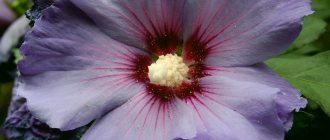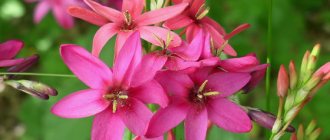From the article you will learn what a globular chrysanthemum flower looks like; photos of the plant are given in the section at the bottom of the article. A detailed description tells about the varieties and varieties of flowers. With the help of this review, you will receive information on how to choose the chrysanthemum you need based on the flowering time. You will become fully familiar with planting, propagating and caring for the plant, and you will be able to protect the flower from diseases and pests. Take advantage of the acquired knowledge and grow a magnificent chrysanthemum in the shape of a ball in your apartment or near your home.
Types and varieties of chrysanthemum, appearance
Globular chrysanthemum is a young variety bred specifically for decorative cultivation; some varieties are suitable for cutting for bouquets. Like all chrysanthemums, the plant belongs to the Asteraceae family.
A huge number of varieties and species of this flower have been bred. There are 16 species of spherical chrysanthemum, and there are several thousand varieties, among them there are both perennial varieties and annual plants. Decorative spherical chrysanthemums grow as a bush, the height of which does not exceed 0.7 m, and the plant acquires the shape of a ball on its own, without additional pruning.
All existing spherical varieties and species are divided into groups according to the height of the bush:
- The border group of chrysanthemums includes flowers with a bush, the height of which is 15-30 cm. In most cases, varieties of this group do not form root shoots, have a natural spherical shape, and bloom starting in the first months of summer. They look beautiful in pots.
- The medium-sized group collected plants with a height of up to half a meter. Plants can be grown for cutting. The varieties are varied, with a wide range of flower colors.
- Tall spherical chrysanthemums reach 70 cm.
According to the timing of flowering, early, middle and late varieties are distinguished. Taking into account the timing of flowering, landscape designers create flower beds that delight the eye with bright colors throughout the warm period of the year, from late June to October. In this case, both border and bush chrysanthemums are used.
Popular varieties of spherical chrysanthemums:
- Chrysanthemum Branindio - blooms in August. Yellow flowers have a golden-orange center, a diameter of 3-7 cm. The bush is highly branched, regular spherical in shape, up to half a meter in height.
- Branfountain varieties bloom from mid-September until cold weather, the diameter of the bush reaches half a meter, the flowers are double, approximately 4 cm in diameter. It has white, purple, salmon, and lemon colored flowers.
- Multiflora Branhill, the bush grows up to 30-40 cm, very lush, covered with flowers (their diameter is up to 5 cm) so that the leaves are not visible. Blooms in August and comes in two colors, Branhill Cherry with light cherry blossoms and Branhill Red with dark red blossoms. This variety can be used to grow low-growing dwarf borders.
- The late chrysanthemum Bransky plum has a tall bush (up to 70 cm) and double flowers of bright plum color, which delight the eye throughout September.
Look in our gallery of chrysanthemum multiflora spherical (varieties) photo selection of 30 colorful images.
Garden chrysanthemums: history and classification
In the photo: Variety “Champagne Splashes”
Not afraid of winds and frosts, chrysanthemums serve as the personification of good spirits and a shining example of strength and perseverance. For more than 3,000 years, these beautiful flowers have been grown in China, which is considered their historical homeland. But the palm is often disputed by Japanese residents, who consider chrysanthemums their national treasure.
It is curious that in Japanese these flowers are called “Kiku”, and the second meaning of this hieroglyph is “Sun”. This is especially symbolic considering that the very first varieties of chrysanthemums were yellow. The golden color gave them the name by which they are now known, because it literally translates as “Golden-colored.”
At the dawn of the 12th century, there were 36 varieties of chrysanthemums. Confucius tried to carry out their first classification. Now there are already more than 10 thousand varieties in the world, and in the Middle Kingdom alone there are more than 3000 of them. The assortment is incredibly wide. There are varieties with large and miniature, rounded and pointed, simple and double petals. The smallest chrysanthemum flower does not exceed 3 cm in diameter. Some garden bushes can grow up to 1.5 m.
It is garden chrysanthemums that are called “autumn queens.” Most often they are classified depending on the diameter of the flowers into three main types.
Small-flowered or Korean varieties impress with many inflorescences on one bush, the diameter of the flowers is from 2 to 10 cm. They are especially frost-resistant and bloom from September until the onset of cold weather and frosts. The most popular are “Talisman” and “Evening Lights”.
In the photo: variety Talisman
Medium-flowered (10-18 cm in diameter) or decorative chrysanthemums serve as decoration for gardens and are used in bouquets. Their height varies between 30-70 cm. These species can also bloom when grown in pots. They are often used to decorate loggias. Among the popular ones are O and “Zorka”.
Large-flowered varieties are the most spectacular. The height of their bushes reaches 80-150 cm with a flower diameter of 10-25 cm. These varieties are the least resistant to cold and are grown mainly for bouquets. The most famous large-flowered chrysanthemum is “Umka”. “Rosetta’s Daughter” is not inferior to her in popularity.
Another criterion for classifying chrysanthemum species is their division into annual and perennial.











